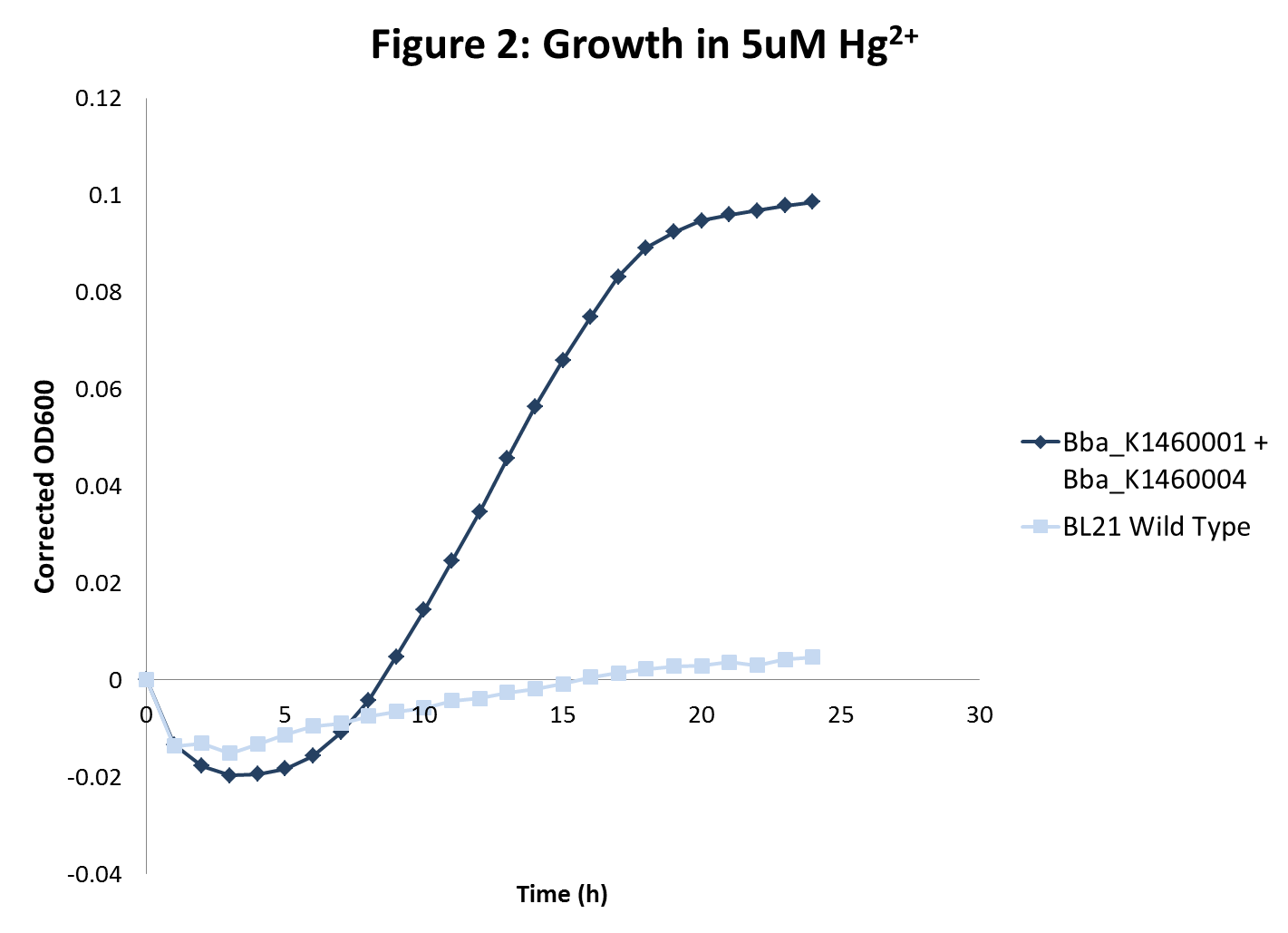Composite
Part:BBa_K1460007:Experience
Designed by: Eric Holmes Group: iGEM14_Cornell (2014-08-26)
This experience page is provided so that any user may enter their experience using this part.
Please enter
how you used this part and how it worked out.
Applications of BBa_K1460007
Cornell 2014 Results
Cells expressing merT and merP as well as metallothionein should have increased tolerance to mercury due to the presence of metallothionein. To test for increased metal tolerance, we grew E.coli BL21 and engineered BL21 with parts BBa_K1460001 (GST-YMT in pSB1C3) and BBa_K1460004 (merT/merP in pUC57) in 5 uM Hg (a mercury concentration we found to be very toxic to wild type BL21 cells). These two genes expressed in conjunction are a functional duplicate of BBa_K1460007.

What we can see from the above chart is that when BL21 engineered with both merT/merP and GST-YMT are grown in a highly toxic concentration of mercury we see significant growth when in wild type BL21 we do not (bottom figure). This suggests that these cells are successfully expressing metallothionein and that this metallothionein is providing the cells with an inherent resistance to mercury toxicity.
Part BBa_K1460004 in pUC57 was co-transformed with part BBa_K1460001 (GST-YMT) in pSB1C3 and selected for with both ampicillin and chloramphenicol to effectively create the mercury sequestration part BBa_K1460007. To test for sequestration efficiency, both BL21 and BL21 engineered with BBa_K1460001 and BBa_K1460004 were grown with LB + 0.1% Arabinose for 8 hours and then diluted by 1/2 with LB + 2 mM Hg for a final mercury concentration of 1 mM. These cultures were grown for 8 more hours. The cells were then removed and supernatant was tested for mercury concentration using Inductively Coupled Plasma Atomic Emission Spectroscopy (ICP-AES) with the help of Cornell's Nutrient Analysis Lab. Error bars in chart represent standard deviation of three biological replicates.
Part BBa_K1460004 in pUC57 was co-transformed with part BBa_K1460001 (GST-YMT) in pSB1C3 and selected for with both ampicillin and chloramphenicol to effectively create the mercury sequestration part BBa_K1460007. To test for sequestration efficiency, both BL21 and BL21 engineered with BBa_K1460001 and BBa_K1460004 were grown with LB + 0.1% Arabinose for 8 hours and then diluted by 1/2 with LB + 2 mM Hg for a final mercury concentration of 1 mM. These cultures were grown for 8 more hours. The cells were then removed and supernatant was tested for mercury concentration using Inductively Coupled Plasma Atomic Emission Spectroscopy (ICP-AES) with the help of Cornell's Nutrient Analysis Lab. Error bars in chart represent standard deviation of three biological replicates.


There was no statistically significant difference between BL21 wild type and BL21 engineered to express merT/merP and GST-YMT in final culture concentration of mercury or mercury sequestered per OD. The mercury concentrations used in this test were much higher than was shown in growth experiments to completely prevent growth of BL21, so it is likely that cells were quickly killed once metal was added, possibly confounding results. To verify this construct is successful in removing mercury from water, we must repeat these experiments using lower concentrations of Hg. We were not able to complete these experiments, however, as the limit of detection of the ICP-AES used to test these metal concentrations is above the uM range necessary to conduct these experiments.
